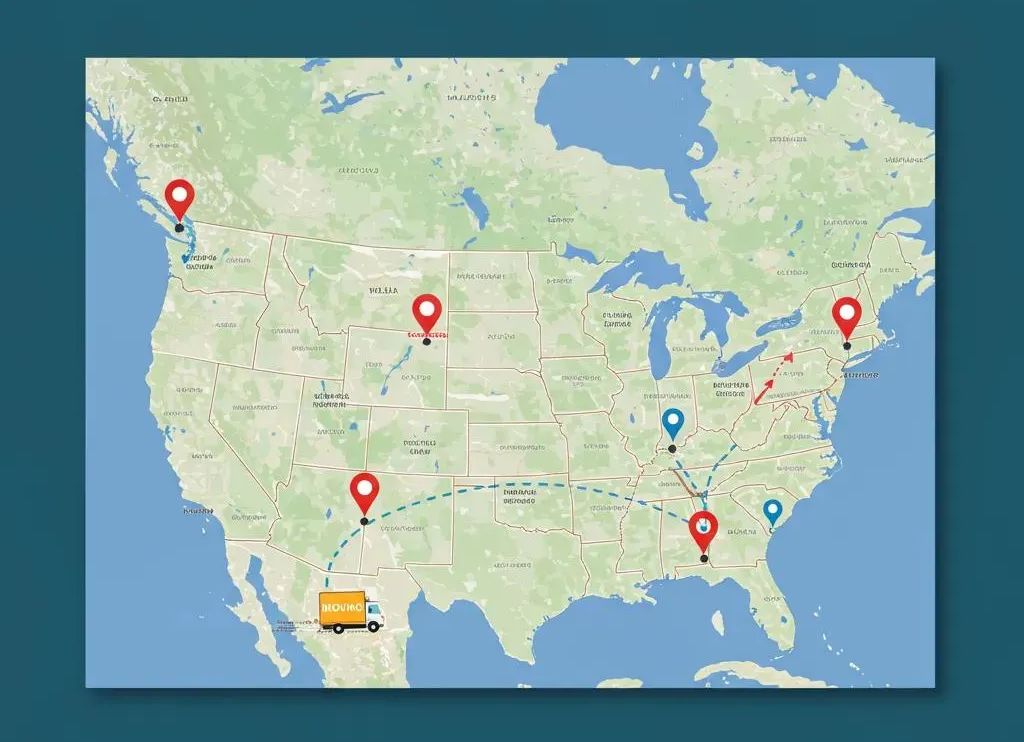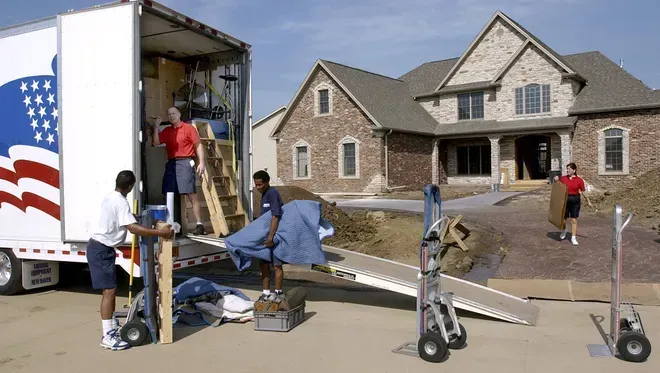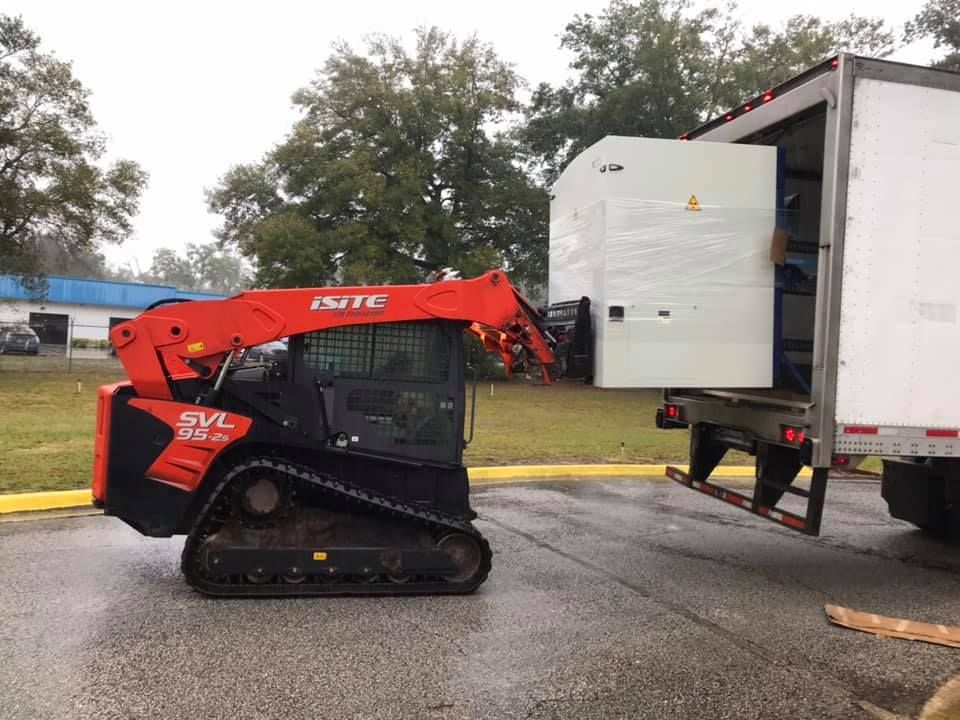BLOG
We Earned Their TRUST...
Now, Let Us Earn Yours!
Understanding Affordable Residential Moving Rates: Your Guide to Transparent Moving Costs

Knowing how affordable residential moving company rates are calculated can save you a significant amount of money and help make your moving day much smoother. With rising costs for labor, fuel, and equipment, a typical local move in 2025 can range from $800 to $2,500. For longer distances, expect costs to start around $2,500 and potentially go over $10,000. This guide will walk you through the main things that affect how much your move will cost, give you real-world price ranges for local and long-distance moves, compare full-service options with doing it yourself, explain extra charges for packing and storage, show you how to get an accurate quote from MOVE IT ALL, and highlight why our clear pricing makes for an affordable and stress-free move. By the time you finish reading, you’ll understand exactly how moving costs are figured out, where you can save money, and why our professional Residential Moving Services handle your household belongings with both care and efficiency.
What Key Factors Influence Residential Moving Costs?
The cost of residential moving is determined by several interconnected factors that dictate the labor, equipment, and logistical planning required. Everything from how far you're moving to how complex packing is directly impacts the final price, as moving companies must allocate resources based on distance, the amount of stuff you have, how easy it is to access your home, and when you need to move. For example, moving a two-bedroom apartment across town will likely cost half as much as moving out of a suburban house with steep stairs and narrow driveways.
| Cost Factor | Impact Level | Explanation |
|---|---|---|
| Distance | High | Longer distances mean more fuel, higher mileage charges, and increased labor time. |
| Volume & Weight | Medium | Lots of items or heavy belongings require bigger trucks and more time from the crew. |
| Residence Accessibility | Medium | Stairs, elevators, or tight doorways can slow down the process and add to the cost. |
| Seasonal Demand | Variable | Moving during busy periods (like summer or the end of the month) often means higher rates. |
| Additional Services | Variable | Services like packing, storage, or special handling will incur extra fees. |
Each of these factors works together to shape your moving estimate, and we’ll now dive deeper into local and long-distance pricing.
How Does Distance Affect Local and Long-Distance Moving Rates?

Distance is the primary factor in determining whether a move is classified as local or long-distance, and it sets the foundation for billing. Local moves, typically within a 50-mile radius, are usually charged by the hour, covering labor, truck use, and fuel. Long-distance moves, on the other hand, are priced based on weight and mileage to account for the complexities of interstate travel, line-haul transportation, and regulatory requirements.
- Local moves are billed hourly, based on crew size and time spent.
- Long-distance moves are priced by weight and the miles traveled.
- Fuel surcharges are adjusted based on the distance of the move.
- Fees may apply for moves that cross state lines.
These pricing models reflect the logistical challenges associated with travel distance, which leads us to how the volume and weight of your belongings also play a role.
Why Do the Volume and Weight of Your Belongings Matter?
The volume and weight of your possessions directly influence the size of the truck needed, the number of movers required, and the level of transport insurance necessary for a residential move. A large, four-bedroom home packed full might require a full-sized moving truck and a crew of six, while a studio apartment could be handled with a smaller van and just two movers. More volume and heavier items mean increased fuel consumption, longer loading times, and potentially higher valuation charges for insurance.
Most moving companies have a minimum weight requirement for long-distance moves, often around 1,000 pounds. For local moves, crews typically estimate hourly needs based on cubic feet. Bulky items like pianos or large appliances often come with special handling fees due to their weight and shape, which is why providing an accurate inventory of your belongings is crucial for getting a precise quote.
How Do Residence Type and Accessibility Impact Moving Prices?
The characteristics of your home, such as which floor you live on, the size of your doorways, and whether you have elevator access, can significantly affect the labor intensity and equipment needed. Moving out of a high-rise apartment without an elevator will require more crew time and protective padding, while moving from a ground-floor single-family home might be quicker but could involve longer carries across yards or driveways.
Accessibility challenges can add 15–30 percent to standard rates when things like steep staircases, narrow hallways, or distant parking spots make handling more difficult. Understanding these potential issues upfront will help you plan for the right resources and avoid unexpected cost increases on moving day.
What Role Do Seasonal Demand and Timing Play in Pricing?
During peak moving seasons—generally from May through September—and on weekends or at the end of the month, demand for movers is highest, which can increase rates by 10–20 percent. Conversely, moving during off-peak months or on weekdays often comes with discounted hourly rates or special flat-fee offers. Moving around holidays might also involve premium surcharges due to limited crew availability.
Booking your move well in advance during busy periods can help you secure better pricing. Being flexible with your moving dates outside of peak times can lower costs and ensure crew availability. Strategically choosing your moving date can help you balance affordability with convenience.
How Do Additional Services Like Packing and Storage Affect Costs?
Extra services such as professional packing, short-term storage, or specialized item handling add convenience but come with additional fees. Packing services are typically billed by the hour or by the item, with average rates ranging from $30 to $60 per mover-hour. Storage solutions are charged daily or monthly based on the unit size, usually starting around $50 per month for a small locker and going up to $200 or more per month for larger units.
Specialty items like pianos, antiques, or fine art require custom crating and insurance valuation, which can add $100 to $500 per item. Including these options in your moving plan ensures you have complete protection and a clear understanding of the total costs before your moving day.
What Are the Typical Costs for Local Residential Moves?
Local residential moving costs are calculated by combining hourly labor rates, truck usage fees, and fuel surcharges into a comprehensive per-hour charge. For affordable local moves, expect rates to generally range from $100 to $200 per hour for a two-person crew and a small van. This can scale up to $300 or more per hour for larger homes that require multiple movers and trucks.
Getting an accurate quote starts with a detailed inventory of your rooms, furniture, and any access challenges. This helps us assign the right crew size. For example, a smooth move for a two-bedroom apartment with no stairs might take 3–4 hours, while a four-bedroom house with stairs could require 6–8 hours. Our transparent pricing model ensures you only pay for the actual time and resources used.
| Home Size | Estimated Crew & Truck | Average Cost Range |
|---|---|---|
| Studio/1BR | 2 movers, small van | $200–$400 |
| 2 Bedroom | 2–3 movers, medium truck | $300–$700 |
| 3 Bedroom | 3–4 movers, large truck | $500–$1,200 |
| 4+ Bedroom | 4+ movers, multiple trucks | $800–$2,000 |
What's the Difference Between Hourly Rates and Flat Fees for Local Moves?
Hourly rates are based on the actual time the crew spends working and the mileage traveled, offering flexibility if your moving needs change unexpectedly but carrying the risk of higher costs if the move takes longer than anticipated. Flat fees provide a fixed total cost based on an initial estimate, protecting you from unexpected charges when the inventory and access details are clearly defined. Hourly rates are best for moves with uncertain volumes or complex layouts, while flat rates offer budget certainty for clients who prefer a guaranteed price.
What Are the Average Price Ranges for Local Moves Based on Home Size?
The average cost of local moves generally increases with the size of your home and the amount of packing required. Studio apartments typically range from $200 to $400, two-bedroom apartments from $300 to $700, and three-bedroom homes can start around $500 and go up to $1,200 or more, especially during busy periods. Larger homes with extensive furniture or delicate items may cost $2,000 or more, particularly if there are stairs or long carries involved.
How Can You Effectively Reduce Local Moving Expenses?
You can lower your local moving costs by decluttering your belongings before the move, packing non-fragile items yourself, scheduling your move for mid-week, and booking outside of peak season. Consolidating smaller moves into a single trip, ensuring easy parking for the movers, and disassembling furniture in advance can also reduce labor time. Sharing photos of your inventory and detailed room dimensions online can help you get more accurate flat-fee quotes and avoid hidden labor charges.
What Should You Expect from Long-Distance Moving Estimates?
Long-distance residential moves are primarily based on weight, mileage, and logistical coordination. Estimates are typically provided as either binding or non-binding quotes, which determine your final payment obligations. A binding estimate guarantees a fixed price based on a pre-move assessment of weight and distance, offering budget stability. A non-binding estimate provides an approximate cost that may change depending on the actual shipment weight or any route adjustments.
To get an accurate long-distance moving price, an in-home survey or virtual walkthrough is usually necessary. This allows the movers to inventory your items, measure access points, and calculate line-haul charges. The cost of insurance and valuation coverage will also be added based on the total declared value of your belongings. Understanding each of these components will help you choose the most transparent and cost-effective estimate.
How Do Binding and Non-Binding Estimates Differ?
A binding estimate locks in the total cost of your move, regardless of the final weight, as long as no additional services are requested, ensuring you won't face unexpected charges. A non-binding estimate sets a preliminary price that could increase or decrease based on the actual shipment weight or changes to the route, offering flexibility but carrying the potential for cost variations. Choosing the right type of estimate depends on whether you prioritize budget certainty or service adaptability.
What Unique Factors Influence Long-Distance Moving Costs?
Long-distance moving rates are influenced by the total weight of your shipment, the travel distance, fuel surcharges, overnight expenses for the crew, tolls, and regulatory fees. Weight is calculated in pounds and priced per hundred pounds, while distance is factored in through line-haul charges per mile. Overnight stays for the moving crew, permits for crossing state lines, and any necessary storage during transit also contribute to the final bill.
How Does Long-Distance Moving Insurance Work and Affect Pricing?
Insurance valuation for long-distance moves is determined by the declared value of your household goods. Basic carrier liability typically covers $0.60 per pound per item, which may not be enough to cover the actual replacement cost. Full-value protection plans usually add 1–3 percent of the declared value to your estimate, ensuring that damaged or lost items are repaired or replaced, and this directly impacts your overall moving budget.
What Does Full-Service Residential Moving Include and How Does It Affect Rates?

Full-service residential moving offers complete support, covering everything from packing and loading to transportation, unloading, and even unpacking. This all-inclusive solution removes the burden of DIY moving, saves you time, and reduces the risk of damage, but it does come at a higher price—typically 20–40 percent more than basic transportation services. For households that value efficiency and careful handling, the extra cost is often well worth the benefits of not having to manage packing and logistics yourself.
Included services usually encompass professional packing supplies, insured transportation, disassembly and reassembly of large furniture items, and careful unpacking at your new residence. By bundling labor, materials, and logistics, full-service packages simplify your budgeting and provide the highest level of protection for your delicate or valuable belongings.
Which Services Are Typically Included in Full-Service Moving Packages?
- Professional packing of all your belongings using high-quality materials.
- Secure crating for special items like antiques, artwork, and pianos.
- Loading and unloading handled by our trained and experienced crews.
- Disassembly and reassembly of your furniture.
- Unpacking services and debris removal to make your move-in as smooth as possible.
Is Full-Service Moving Worth the Additional Cost?
Investing in full-service moving provides peace of mind, frees up your personal time, and minimizes the risk of damage thanks to professional handling. While the overall cost might be higher than renting a truck and hiring hourly labor yourself, the convenience of managed logistics, liability coverage, and expert packing often makes it a worthwhile premium for busy families and those relocating valuable possessions.
How Does Full-Service Moving Pricing Compare to DIY or Partial Services?
When comparing your options, a DIY truck rental combined with hourly labor might seem cheaper initially, but it doesn't include packing supplies, skilled labor, or insurance beyond basic liability. Partial services, such as loading-only or packing-only, typically cost between $30 and $60 per mover-hour. In contrast, full-service hourly rates for a three-person crew average $150–$250. A detailed comparison table can help you understand the trade-offs between doing it yourself, partial services, and the comprehensive benefits of full-service moving.
What Are the Costs of Additional Moving Services and Supplies?
Beyond the core transportation, a range of extra services can help you customize your move to fit your specific needs. Professional packing services start at $30 per mover-hour, and specialized packing boxes cost around $5–$10 each. Reusable wardrobe boxes or heavy-duty picture crates may have separate rental fees. Storage solutions vary by unit size, with small lockers starting at $50 per month and large climate-controlled units costing over $200 per month.
Specialty items like pianos, safes, and wine collections incur handling fees ranging from $100 to $500 per item, reflecting the need for custom crating and specialized equipment. Insurance upgrades and valuation plans typically add 1–3 percent of the declared value. Including these additional costs in your quote ensures complete transparency and helps you manage your budget effectively.
How Much Do Packing Supplies and Professional Packing Services Cost?
Professional packing labor typically costs between $30 and $60 per mover-hour, depending on the crew size and the fragility of the items being packed. Packing materials generally cost about $5 for a small box, $10–$15 for a large box, and $20–$30 for a specialty crate. Buying supplies in bulk can often reduce the per-item price.
What Are Storage Solutions and Their Associated Fees?
We offer both short-term and long-term storage options, with prices varying based on unit size and whether climate control is needed. Standard units (5×5 ft) usually start at $50 per month, medium units (10×10 ft) range from $100 to $150 per month, and large climate-controlled units can cost over $200 per month. Some facilities may charge access fees or have minimum rental periods.
How Are Specialty Items Like Pianos or Antiques Priced?
Handling specialty items involves custom crating, specialized equipment, and extra labor. Moving a piano typically costs between $200 and $500, while handling antiques can range from $100 to $300 per piece, and artwork costs $50 to $150 depending on its size and fragility. Insurance coverage is adjusted to reflect the replacement value of these items.
What Insurance and Valuation Options Are Available and How Do They Affect Costs?
Basic carrier liability covers $0.60 per pound per item at no additional charge. Full-value protection, which offers more comprehensive coverage, adds 1–3 percent of the declared shipment value to your estimate. Third-party valuation plans provide additional coverage tiers and deductibles, which will directly influence your total moving costs.
How Can You Get an Accurate and Affordable Moving Quote from MOVE IT ALL?
Getting a precise and budget-friendly quote starts with providing a thorough inventory and clearly communicating the details of your move. MOVE IT ALL’s quote process includes a virtual walkthrough or an in-home assessment, along with detailed item lists, notes on access, and your preferred timing. This allows us to create binding or non-binding estimates tailored to your specific needs. Providing accurate room counts, furniture dimensions, and descriptions of any specialty items ensures that your estimate closely matches the final invoice.
What Information Do You Need to Provide for a Precise Quote?
- Your exact move date and preferred time window.
- A detailed list of your rooms and major furniture pieces.
- Notes on any stairs, elevators, or tight entryways.
- A list of specialty items that require crating or extra care.
- Information on whether you need packing services or storage.
How Does MOVE IT ALL’s Quote Process Ensure Transparency and Fair Pricing?
MOVE IT ALL uses a standardized Rate Card system with clearly defined hourly rates, mileage brackets, and service surcharges. Every estimate provides a detailed breakdown of labor, truck charges, materials, and insurance, so you can see exactly what contributes to each cost. Our binding quotes guarantee your price, and our non-binding quotes clearly outline any potential adjustments, ensuring there are no surprise fees on moving day.
What Tips Can Help You Save Money When Requesting a Moving Quote?
- Declutter your belongings before the assessment.
- Schedule your move for mid-week and during off-peak times.
- Handle the packing of non-fragile items yourself.
- Consolidate multiple small shipments into a single move.
- Confirm parking accessibility and loading dock availability at both locations.
Why Choose MOVE IT ALL for Affordable Residential Moving Services?
MOVE IT ALL stands out with its commitment to transparent pricing, professional care, and local expertise, making every residential relocation stress-free and competitively priced. Our specialized Residential Moving Services are supported by a consistent Rate Card, clear service definitions, and a local team that understands regional traffic patterns, building regulations, and neighborhood specifics. This combination ensures your move is handled efficiently and affordably from beginning to end.
We leverage our local presence—backed by a strong Google Business Profile—to optimize route planning, minimize downtime, and pass those savings directly on to you. Every move includes insured transport, experienced crews, and flexible scheduling, demonstrating our unwavering dedication to providing excellent value and ensuring customer satisfaction.
How Does MOVE IT ALL Ensure Transparency and Affordability in Pricing?
Our transparent Rate Cards, binding quotes, and clear breakdowns of every labor hour, mileage bracket, and service surcharge guarantee that you know exactly what you're paying for. We eliminate hidden fees by requiring detailed move assessments before confirmation and by clearly outlining all potential add-on services in writing.
What Local Expertise Does MOVE IT ALL Offer for Residential Moves?
Our local team's in-depth knowledge of traffic patterns, building access rules, and preferred loading zones streamlines the logistics of moving in and out. Familiarity with regional regulations helps prevent delays and avoids extra permit fees, while our established relationships with local suppliers ensure we use quality materials at competitive prices.
How Can You Request a Free, No-Obligation Quote Today?
Contact our Residential Moving Services team with your move details—including room counts, furniture inventory, and ideal dates—to receive a precise estimate with no commitment. Our transparent process and clear rate definitions provide the clarity you need to plan a smooth and affordable relocation.
Moving doesn't have to be a financial strain or a logistical nightmare. With a thorough understanding of cost factors, available service packages, and an expert partner guiding you every step of the way, you can book your move with confidence and focus on settling into your new home. Reach out to us now to secure your transparent, affordable residential moving rate with MOVE IT ALL.













